
PUMPA - SMART LEARNING
எங்கள் ஆசிரியர்களுடன் 1-ஆன்-1 ஆலோசனை நேரத்தைப் பெறுங்கள். டாப்பர் ஆவதற்கு நாங்கள் பயிற்சி அளிப்போம்
Book Free DemoIntroduction:
In 1892, Dmitri Ivanovsky, a Russian botanist, used a bacteria filter to filter the sap of a disease affected tobacco plant. When he applied this filtered sap to a healthy tobacco plant, he observed that plant also gets infected. So he decided that something smaller than bacteria present in our environment, causing the disease in tobacco leaves. In 1898, Martinus W. Beijerinck called these filtered infectious sap with the name Virus.
Important!
- The term virus was derived from Latin refers 'Venom'; or poisonous fluid.
- Virology deals with studying various types of viruses, their characteristics and viral diseases.
- Viruses are defined as infectious agent that only replicate inside a host cell.
Characteristic features of virus:
Structure of the virus:
Viruses are non-cellular and self-replicating parasites, surrounded by a protective coat of protein called Capsid, which covers a genetic material (central nucleic acid molecule, DNA or RNA).
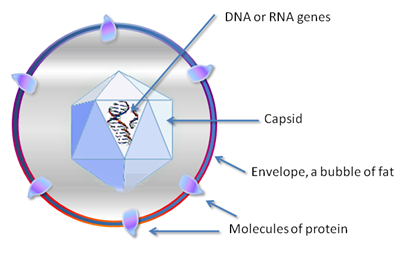
Since viruses exhibit both living and non-living characteristic features, they are considered living and non-living thing.
Living characteristics | Non-living characteristics |
They have nucleic acid, either RNA or DNA, which means the genetic material can replicate. | Viruses remain as inert material outside their hosts. |
A virus can multiply in the living cells of the host. | They are devoid of the cell membrane and cell wall. They are also devoid of cellular organelles like ribosomes, mitochondria, etc. |
They can attack specific hosts. | They are in the form of crystallisation. Viruses do not respire and do not metabolise |
Types of virus:
Based on its shape:
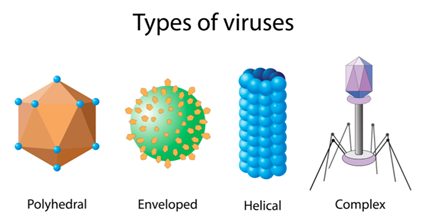
1. Polyhedral
Example:
Adenovirus, Rhinovirus and Poliovirus
- Have you ever get infected, with Madras eye disease (conjunctivitis). And how did the name madras eye come about? It originated due to adenovirus, which causes madras eye, was first identified in Madras in 1918. If you have notice carefully, this disease will always occur within your locality and not throughout the country? Hence it is called as an endemic disease.
- The rhinovirus is the most common viral infectious agent in humans, and it is the most common cause of the common cold.
- Poliomyelitis is also known as polio. It is a disabling and potentially fatal disease caused by the poliovirus.
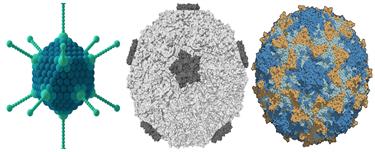
Left to right: Adenovirus, Rhinovirus and Poliovirus
2. Enveloped
Example:
Human immunodeficiency virus (HIV), Coronavirus and Influenza virus.
- HIV is a virus that attacks the immune system of the body. HIV can lead to AIDS if it is not treated (Acquired Immunodeficiency Syndrome).
- Coronavirus disease (COVID-19) is a contagious disease caused by a newly discovered Coronavirus.
- Influenza disease, commonly known as "the flu," is a respiratory illness caused by RNA viruses (Myxovirus) that infect many animals, birds, and humans.

Left to right: Human immunodeficiency virus, Coronavirus and Influenza virus
3. Helical
Example:
Tobacco mosaic virus (TMV), Measles virus and Mumps virus.
- TMV is a single-stranded RNA virus in the genus Tobacco virus that infects various plants, particularly tobacco.
- Measles is an infectious disease caused by the Rubeola Virus
- The Myxovirus parotidis causes mumps. This virus is common cause of infection, especially among children which results in an enlargement of parotid gland.
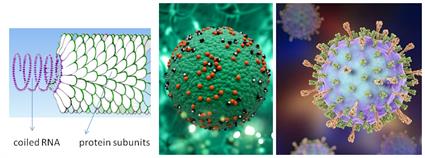
Left to right: Tobacco mosaic virus (TMV), Measles virus and Mumps virus
4. Complex
Example:
Bacteriophage and Poxviruses such as smallpox, monkeypox, cowpox.
- Bacteriophage, also known as phage or bacterial virus, is a type of virus that infects bacteria.
- Poxviruses have large double-stranded DNA genomes and are brick or oval. They are found all over the world and cause disease in humans and many other animals. It causes infections commonly cause by lesions, skin nodules, or a disseminated rash.
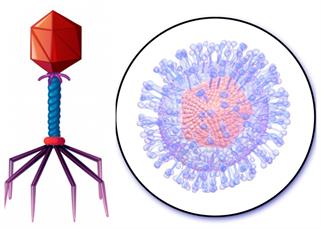
Left to right: Bacteriophage and Chicken Pox
Reference:
https://upload.wikimedia.org/wikipedia/commons/e/e6/Virus_structure_simple.png
https://upload.wikimedia.org/wikipedia/commons/6/6a/Adenovirus_3D_schematic.png
https://upload.wikimedia.org/wikipedia/commons/e/ef/Rhinovirus_001.png
https://upload.wikimedia.org/wikipedia/commons/b/bc/Polio-3-chains.png
https://upload.wikimedia.org/wikipedia/commons/e/ef/Rhinovirus_001.png
https://upload.wikimedia.org/wikipedia/commons/b/bc/Polio-3-chains.png
https://upload.wikimedia.org/wikipedia/commons/e/eb/3D_medical_animation_corona_virus.jpg
https://www.freepik.com/free-vector/close-up-diagram-hiv-virus_4228026.htm#page=1&query=hiv&position=1
https://www.freepik.com/free-vector/close-up-isolated-object-virus-named-influenza-virus_6609300.htm#page=1&query=influenza%20virus&position=1
https://www.freepik.com/free-vector/close-up-diagram-hiv-virus_4228026.htm#page=1&query=hiv&position=1
https://www.freepik.com/free-vector/close-up-isolated-object-virus-named-influenza-virus_6609300.htm#page=1&query=influenza%20virus&position=1
https://commons.wikimedia.org/wiki/File:Chicken_Pox_(Varicella_Zoster).jpg
https://www.freepik.com/free-photos-vectors/bacteriophage